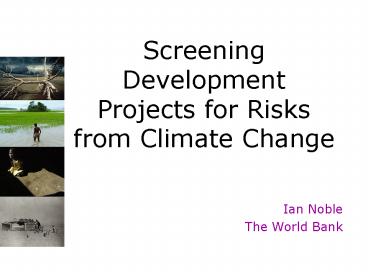Screening Development Projects for Risks from Climate Change - PowerPoint PPT Presentation
1 / 27
Title:
Screening Development Projects for Risks from Climate Change
Description:
Levels of advice provided ... Experts. A framework for a ... Based on best expert advice? Additional tools. Document database. Project database. Experts ... – PowerPoint PPT presentation
Number of Views:47
Avg rating:3.0/5.0
Title: Screening Development Projects for Risks from Climate Change
1
Screening Development Projects for Risks from
Climate Change
- Ian Noble
- The World Bank
2
The conventional view of adaptation
- Adaptation to CC is an additional cost to
developing countries and thus should be funded by
those responsible - There is a high degree of uncertainty in climate
projections - Form collaborative links with international
organisations - Improve our projections of climate change
- Identify hot spots
- Understand traditional coping strategies
- Build capacity in all sectors
- Mainstream adaptation into the development
process
3
Current Adaptation ProjectsUsual Outcome
- Assess literature
- Assess current and future vulnerability
- Increase local forecasting capacity (downscaling)
- Assess institutional structures
- Develop adaptation options
- Costing and prioritizing
- Implement priorities
- Monitor and assess outcomes
- Compare lessons learnt
4
A restated message
- Based on these major points
- Urgency - climate change is occurring now
- Climate variability and change is currently a
threat to development. - Start by dealing with capacity to cope with
current climate variability - We know enough about the nature of climate change
to take sensible decisions about adaptation now - Can we assess (do we need to) the costs of
adaptation?
5
We can act now
- We will never be able to predict climate with the
precision that we would like - But, we already know enough about the core
climate trends to make sensible decisions about
adaptive measures - Most actions have to start with current coping
(in)capacities with current climate variability
6
ADAPTA Screening Design Tool for adapting
projects to climate change
7
Goals
- Raise profile of adaptation to climate change in
project planning - Screening - Identify the level of risk in a
project - Simple five level classification
- Design - Guide to options to minimise risk where
necessary, based on - Past experience within World Bank and other
relevant agencies national and multinational - Recent research results
8
Screening design tool
- Target Project developers (national, bilateral
and multilateral) and assessors NGOs - Increase awareness of the issue
- Provide a first (quick) check of potential issues
(by region sector)
- Levels of advice provided
- Red flag adaptation issues are important and
must taken into account - Yellow flag some concerns, that should be
checked - Orange Not enough known to assess
- Green flag No adaptation issues foreseen
- Blue flag Positive action for adaptation
9
A framework for a screening design tool
What do project managers need?
10
A framework for a screening design tool
Bring together the expanding database of
information
Good Practice Interpretation
11
A framework for a screening design tool
Provide a screening tool to guide user to
appropriate material
12
A framework for a screening design tool
Based on best expert advice?
13
A framework for a screening design tool
What does the user see?
A series of questions about their project
14
Tool for Adaptation to Climate Change TACC
15
Help about the question and about each option
Ability to change ones mind
16
Users are asked to identify the location of their
project. This can either be via lat-long
coordinates or pointing to a map
The underlying climate change data base will be
based on expert assessment of the various models
and of recent trends. A composite map
representing climate change for each variable
over the next 20 to 30 years will be prepared.
17
(No Transcript)
18
Printed summary
19
(No Transcript)
20
The tool is being designed and implemented
initially in Excel. It has a number of tools to
help users to expand or modify the knowledge
base. Later it will be converted to a web-based
script. The tool and many of the documents will
fit on a CD
21
Each document has a brief summary describing its
relevance
Users can add to the document data base if they
wish
22
Integrated Modeling System GUI
23
Contact inoble_at_worldbank.orgfiqbal1_at_worldbank.
org
- Working in cooperation with several other
agencies and NGOs. - The tool and data-base will be available for
unrestricted distribution - Nine other agencies have expressed interest in
using or cooperating in designing the tool
24
(No Transcript)
25
(No Transcript)
26
(No Transcript)
27
(No Transcript)































